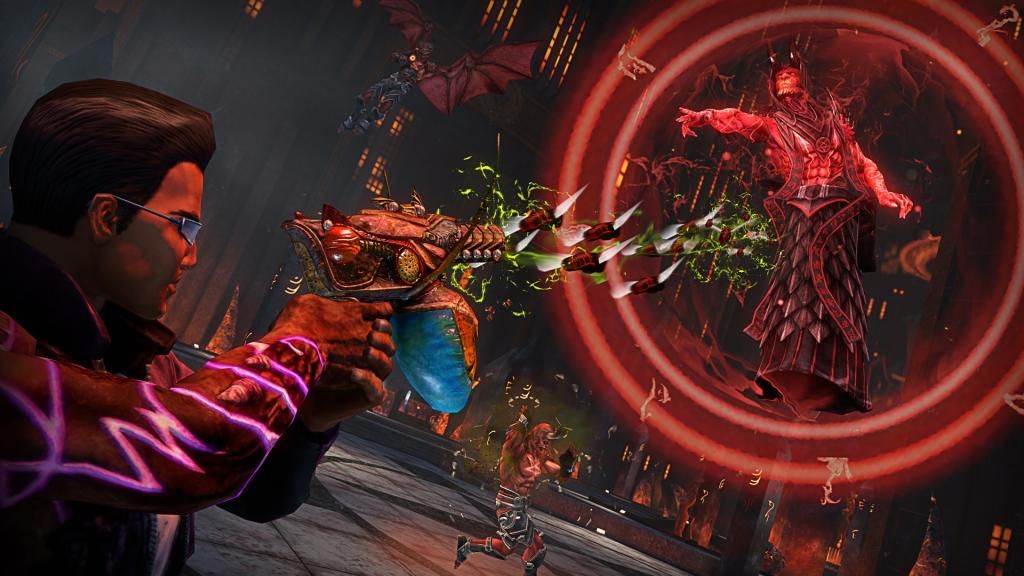- Format: Xbox One (version reviewed), PS4, PS3, 360, PC
- Unleashed: Out now
- Publisher: Deep Silver
- Developer: Volition/High Voltage
- Players: 1 (offline), 2 (online)
- Site: http://www.deepsilver.com/en/home/
- Game code provided by Xbox
Saints Row has always been cheerful in its pilfering from other open-world games; and now with typical glee it follows in the footsteps of GTA, Assassin’s Creed, and inFamous with a “standalone expansion”. Saints Row IV may have turned the silliness up to 10, but Gat Out of Hell turns it up to 11.5. The US president/Saints Row gang member has been kidnapped by Satan, who plans to force him to marry his daughter. Two of the president’s chums go to Hell to help him, and one of those chums is Johnny Gat. ‘Gat out of hell’, you see? Like the Meatloaf song ‘Bat out of Hell’, or perhaps ‘Get out of hell’ because they all want to leave, but with one letter changed. It’s a hilarious play on words!
Excuse the snark, but we couldn’t resist. There’s plenty we’re not keen on in Gat Out of Hell, but the writing is actually one of the stronger points. The game doesn’t take itself seriously for a second; there’s even a musical number in there (yes, really). Most of the jokes score a hit, and once or twice the game might even make you laugh out loud. Unfortunately, the game’s structure tends to squander some good writing, an asset which is still depressingly rare in this industry.
If you’ve played the last few Saints Row games, Hell may look oddly familiar, although it’s not exactly Steelport. The buildings and general landscape are dull and vaguely ominous, with the occasional strange light or big spiky thing; the hapless citizens are shuffling shrivelled ‘husks’, souls of the damned; and rather than police or gang members, there are demons with semi-automatic weapons (though admittedly a handful of them are huge, and many can fly and/or have supernatural powers). These changes certainly aren’t for the better, though. The city has been rendered more dull and uninteresting than ever, and no amount of glowing collectables can fix that.

There are still vehicles in hell, suitably rusted and damaged things. You’ll rarely feel the need to jump in one past the prologue, though. The faster-than-cars running from IV returns, and here you get a pair of wings too. Soaring through the skies is pleasingly intuitive and easy; when you’ve upgraded your abilities still further, you’ll be able to fly over or leap up the side of even the tallest building in seconds. Getting around in this game is nice and easy, and nothing ever seems too far away. Sadly, once you’ve got where you’re going, you probably won’t be enjoying yourself quite so much.
No matter what the game has tasked you with, it will almost certainly involve hitting and/or shooting and/or blowing up stuff. Nothing wrong with that. Combat controls are good, with competent aiming sensitivity and an easy-to-see reticule (we hope you’re taking notes, Rockstar). Damningly (ha! We made a funny!), none of the weapons ever feel particularly satisfying to use, even after major upgrading. Very few of them pack a serious punch, and those that do arguably stretch in the opposite direction, being overpowered. You get some magic powers to play around with; but by the time you’ve upgraded any one enough to turn it into a fearsome weapon, you will have already seen everything the game has to offer in terms of gameplay several times.
Even worse, the shonky frame rate can hold back the action; nowhere near bad enough to ruin the game, but enough to ensure the most hectic fights never feel as smooth as they should. Generally speaking, in fact, the current gen versions are extremely disappointing visually. We haven’t seen the PS3 and 360 versions running, but we’d be shocked if they weren’t identical to the versions running on their more expensive counterparts.

Okay, we DO like this weapon. But how could we not?
The aforementioned script-squandering structure comes from the fact that there’s only half a campaign in the traditional sense. There are a handful of story missions, but after the first few, they’re only triggered by incurring Satan’s wrath to a certain degree (which you can track by the handy Satan’s Wrath meter in the menus). The basic idea is that you cause chaos to enrage Satan (and push the story along) until you finally have his full attention, and the final confrontation can be had. Apparently, Satan is made angry by you taking part in checkpoint races. Also by you causing Mayhem in mini-missions where you cause huge destruction, surviving against waves of enemies, capturing points in a small section of map…oh, we’re sure you get the idea. It certainly came close to enraging us, having to repeat the exact same mission structures several times in areas with negligible aesthetic difference.
Goading Satan enough for the final fight (after which, surprisingly, you get a choice of endings) will likely only take you 4-5 hours. There’s plenty to do after that – hundreds of collectables, plenty of city to explore, dozens of optional missions to take, challenges to retry and improve your score on – but we’re not convinced that the majority of people will want to keep coming back. Playing with a friend is always guaranteed to improve the experience, but there are many better games you could be playing with them.









Comments